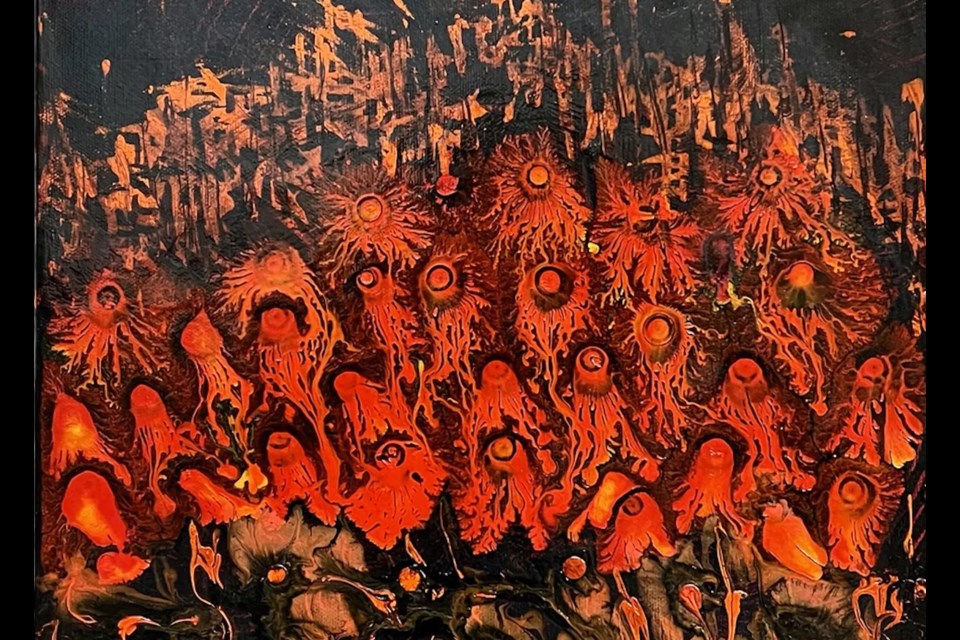CANMORE – Solastalgia is a term that refers to psychological distress caused by environmental change, particularly in one’s own familiar surroundings.
For artists Meg Nicks, of Canmore, and Micha Bandini, living in the Tuscan mountains of Italy, it’s feeling homesick without ever leaving home. The concept is explored in their shared exhibition at artsPlace, titled Solastalgia: Spirit of Place.
“For me, there’s a sense of loss and sometimes shock in all the changes,” said Nicks. “When I was younger, I took things like climbing glaciers for granted. They were just always there and part of the landscape.”
Through painting, abstract art, collage and other mediums, the artists – who met in a virtual art workshop during the COVID-19 pandemic – reflect on the effects of climate change on the natural world and the human psyche.
Nicks said she recently visited the Columbia Icefield in Jasper National Park and was moved to tears as she looked upon the Athabasca Glacier. It was visibly much smaller than she remembered.
“It was just this chill that sank in. This is not just some theory, we are in this environment and it is changing rapidly,” she said.
“I think the quest of an artist in this is trying to figure out how to bring what we know intellectually into an emotional realm, or a realm that touches you on a feeling level.”
One of Nicks’ works, called Requiem, contemplates the effects of glacial melt. It also references glacier ice core research, which provides information about changing atmospheric carbon dioxide levels and climate stability.
Glacial movement is affected by climate, but unprecedented global warming has resulted in a widespread retreat of glaciers that outpaces any advances. By current measurements, the Athabasca Glacier is retreating at a rate of about five metres per year.
Markers of the ice sheet dating back to 1890 reveal the glacier's edge has receded by 1.5 kilometres, uncovering a less familiar terrain of rocks and gravel.
Bandini, who found a home in the town as an artist in residency at the Banff Centre in 2017, was similarly struck by the stark landscape of a wildfire that burned its way through a forested area of Banff National Park.
“When I first arrived, the air was thick with smoke, yellow with fumes, the sunset a sorry affair,” Bandini said in an email. “You could hardly see the wonderful view of the valley from the dining hall. Eventually it cleared but my first impression was: gosh this place is so much bigger than home, but as fragile.”
Bandini described her current home as once stable volcanic, old land, “inhabited and tilled since the bronze age.”
Now, she said, is different.
“The climate is unrecognizable even from when I first arrived (15 years ago),” she said. “The first year we had snow. It hasn’t occurred since. It’s getting hotter, drier, with disastrous floods due to violent thunderstorms. As in the Bow Valley, we too depend on tourism and a bit from agriculture. So, the landscape is important here as much as it is for you.”
Seeing the aftermath of the Banff fire inspired one of Bandini’s pieces in the show which depicts trees having recently fallen or on their last limb, scattered against the landscape.
“It’s certainly one of the things you see when you go to an area that has just burned. There’s just these skeletons of trees everywhere,” said Nicks.
Some of the artwork, including a piece on the flood, are “fairly dark” portrayals of climate change, she added. The intent of the artists is not to dismay the viewer, though.
Bandini said she hopes it encourages the possibility to “think, to discuss and act, perhaps feeling a little threatened, but knowing that by getting together [people] can change a dire outcome.”
The exhibition is also a demonstration of the development of Nicks and Bandinis’ friendship. The two have never met in-person but have grown close through their shared interest and working together overseas. At the centrepiece of the show is a display of folded paper boats representing their communication across the world.
“It would be too easy to be dragged down by all of it,” said Nicks. “You also have to think about what it is about nature that is healing because there are healing aspects to it as well.”
Nicks used the black fire beetle as an example. Where a charred forest may lack the vital resources that most species need to survive, for fire-loving insects such as the black fire beetle, it’s an ideal place to hatch the next generation, which will help bring to life a new, healthy forest.
The show opened at artsPlace April 26 and ends May 21.
The Local Journalism Initiative is funded by the Government of Canada. The position covers Îyârhe (Stoney) Nakoda First Nation and Kananaskis Country.




